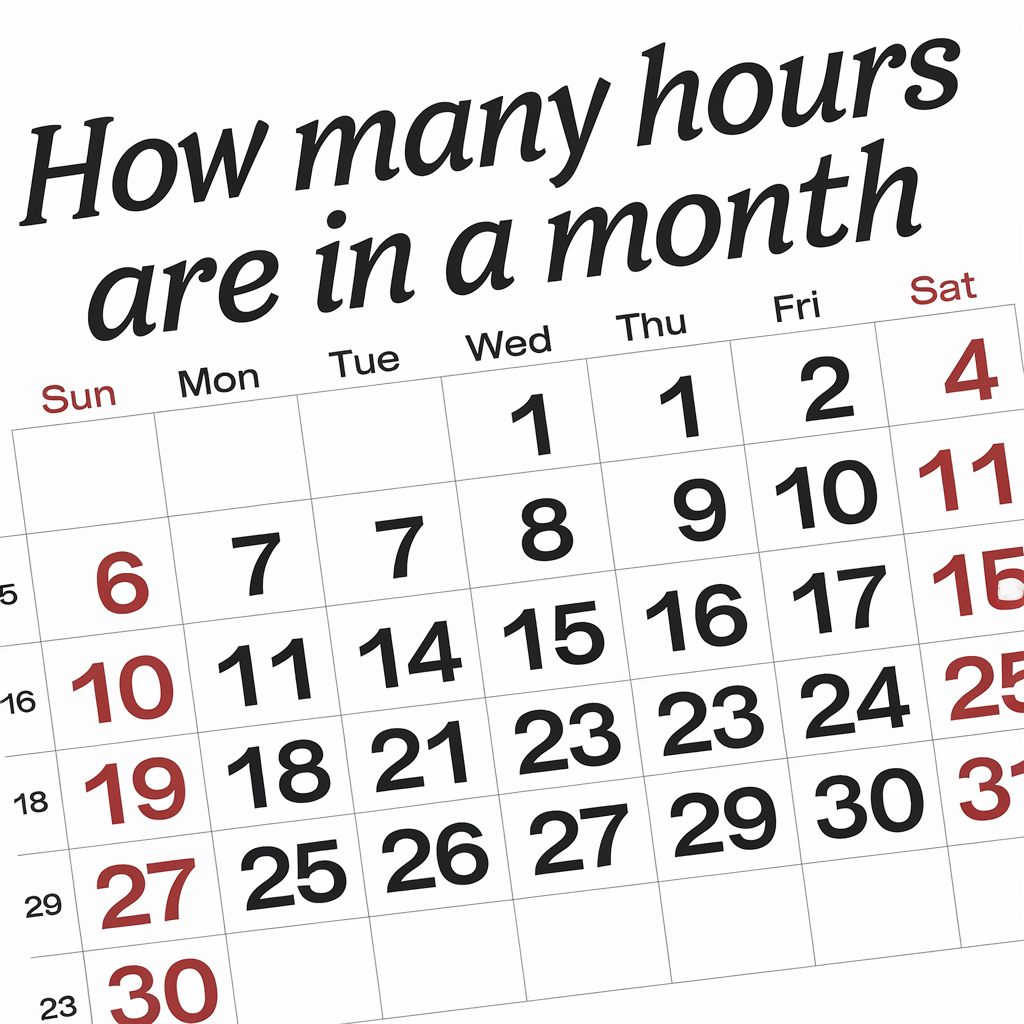Introduction
Understanding the number of hours in a month can seem like a simple question, but the answer varies depending on the month and the year. This knowledge is essential for various aspects of life, from budgeting and planning to scheduling appointments and managing time effectively. In this article, we will explore how many hours are in a month, the differences between various months, and the implications of these differences for our daily lives.
The Basic Calculation
To determine how many hours are in a month, we first need to know how many days are in that month. The basic formula to calculate the number of hours in a month is:
Hours in a Month=Days in the Month×24\text{Hours in a Month} = \text{Days in the Month} \times 24Hours in a Month=Days in the Month×24

If you are facing a tooth infection and want to know that How Long Until a Tooth Infection Kills You then check out our previous blog post.
1. Standard Months
Most months have either 30 or 31 days, with February being the exception. Here’s a breakdown of the standard months:
- 31-Day Months: January, March, May, July, August, October, December
- Calculation: 31 days×24 hours=744 hours31 \, \text{days} \times 24 \, \text{hours} = 744 \, \text{hours}31days×24hours=744hours
- 30-Day Months: April, June, September, November
- Calculation: 30 days×24 hours=720 hours30 \, \text{days} \times 24 \, \text{hours} = 720 \, \text{hours}30days×24hours=720hours
- February:
- In a common year: 28 days×24 hours=672 hours28 \, \text{days} \times 24 \, \text{hours} = 672 \, \text{hours}28days×24hours=672hours
- In a leap year: 29 days×24 hours=696 hours29 \, \text{days} \times 24 \, \text{hours} = 696 \, \text{hours}29days×24hours=696hours
2. Monthly Breakdown
Here’s a complete overview of the number of hours in each month:
| Month | Days | Hours |
|---|---|---|
| January | 31 | 744 |
| February | 28 | 672 |
| February (Leap Year) | 29 | 696 |
| March | 31 | 744 |
| April | 30 | 720 |
| May | 31 | 744 |
| June | 30 | 720 |
| July | 31 | 744 |
| August | 31 | 744 |
| September | 30 | 720 |
| October | 31 | 744 |
| November | 30 | 720 |
| December | 31 | 744 |
3. Average Hours in a Month
To find an average for general calculations, you can total the hours for each month and then divide by 12:
- Total hours for common year months:
- 744 hours×7 (months)=5208744 \, \text{hours} \times 7 \, (\text{months}) = 5208 744hours×7(months)=5208
- 720 hours×4 (months)=2880720 \, \text{hours} \times 4 \, (\text{months}) = 2880 720hours×4(months)=2880
- 672 hours×1 (month)=672672 \, \text{hours} \times 1 \, (\text{month}) = 672 672hours×1(month)=672
- Average hours in a month:
- 8760 hours12 months=730 hours \frac{8760 \, \text{hours}}{12 \, \text{months}} = 730 \, \text{hours}12months8760hours=730hours

If you are facing a tooth infection and want to know that How Long Until a Tooth Infection Kills You then check out our previous blog post.
Implications of Monthly Hours
Understanding the number of hours in a month is crucial for several reasons, including time management, financial planning, and project scheduling.
1. Time Management
Knowing how many hours are in a month helps individuals manage their time effectively. For example, if you have a monthly deadline, understanding the number of hours available can help you allocate tasks accordingly.
2. Work Hours and Salary Calculations
For professionals, knowing how many hours are in a month is essential for salary calculations. For example, if you work a standard 40-hour work week, you can determine your expected hours for the month:
- Average Work Hours in a Month:
- 40 hours/week×4 weeks=160 hours40 \, \text{hours/week} \times 4 \, \text{weeks} = 160 \, \text{hours}40hours/week×4weeks=160hours
However, this can vary depending on the month. For months with five weeks, you could work up to 200 hours, whereas shorter months might see less.
3. Budgeting and Financial Planning
In budgeting, understanding monthly hours can help when calculating expenses related to time. For instance, if you’re planning on hiring someone for a monthly project, knowing how many hours they will work can help you budget accordingly.
Practical Applications
1. Project Management
In project management, timelines are often created based on the number of working hours in a month. Knowing the total hours helps in estimating project duration and resource allocation.
2. Fitness and Health Goals
For those setting monthly fitness goals, tracking hours spent on workouts or activities can provide valuable insight into progress and help in setting realistic targets.
3. Education and Study Planning
Students can also benefit from knowing how many hours are available in a month. This understanding allows them to allocate study time effectively, plan for exams, and balance extracurricular activities.
Leap Years and Their Impact
Leap years, which occur every four years, introduce an extra day in February. This can affect calculations for certain projects or plans that span multiple months, especially those tied to deadlines or financial forecasts.
Example of a Leap Year Calculation
If you’re planning a project over a leap year, the additional hours in February (696 instead of 672) should be accounted for in your overall timeline. This can provide you with an extra 24 hours, potentially allowing for additional work or a buffer period.

If you are facing a tooth infection and want to know that How Long Until a Tooth Infection Kills You then check out our previous blog post.
Conclusion
In summary, the number of hours in a month varies significantly depending on the specific month and whether it’s a leap year. On average, a month has approximately 730 hours, but individual months can have anywhere from 672 to 744 hours. Understanding this can greatly benefit various aspects of life, from work and budgeting to personal planning and goal-setting.
Whether you’re a student, a professional, or someone looking to manage your time better, keeping track of how many hours are in each month can help you plan effectively and make the most out of your time. Knowing how to allocate your hours efficiently can lead to greater productivity and a more balanced life.


